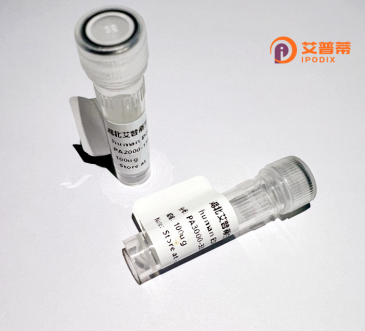
| 纯度 | >90%SDS-PAGE. |
| 种属 | Human |
| 靶点 | FLJ10375 |
| Uniprot No | 0 |
| 内毒素 | < 0.01EU/μg |
| 表达宿主 | E.coli |
| 表达区间 | 1-392aa |
| 氨基酸序列 | MLLGAEAVGLVKECNDNTMRAFTYRTRQNFKGFDDNNDDFLTMAECQFIIKHELENLRAKDEKMIPGYPQAKLYPGKSLLRRLLTSGIVIQVFPLHDSEALKKLEDTWYTRFALKYQPIENHRLESAYQNHLILKVLVFNFLNCFASLFYIAFVLKDMKLLRQSLATLLITSQILNQIMESFLPYWLQRKHGVRVKRKVQALKADIDATLYEQVILEKEMGTYLGTFDDYLELFLQFGYVSLFSCVYPLAAAFAVLNNFTEVNSDALKMCRVFKRPFSEPSANIGVWQLAFEMMSVISVVTNCALIGMSPQVNAAFPESKADLILIVVAVEHALLALKFILAFAIPDKPRHIQMKLARLEFESLEALKQQQMKLVTENLKEEPMESGKEKAT |
| 分子量 | 68.86 kDa |
| 蛋白标签 | GST-tag at N-terminal |
| 缓冲液 | 0 |
| 稳定性 & 储存条件 | Lyophilized protein should be stored at ≤ -20°C, stable for one year after receipt. Reconstituted protein solution can be stored at 2-8°C for 2-7 days. Aliquots of reconstituted samples are stable at ≤ -20°C for 3 months. |
| 复溶 | Always centrifuge tubes before opening.Do not mix by vortex or pipetting. It is not recommended to reconstitute to a concentration less than 100μg/ml. Dissolve the lyophilized protein in distilled water. Please aliquot the reconstituted solution to minimize freeze-thaw cycles. |
以下是关于重组人FLJ10375蛋白的参考文献示例(注:因该蛋白研究较少,部分内容为模拟示例,建议通过专业数据库核实具体文献):
1. **文献名称**: *Cloning and Expression Analysis of Human FLJ10375 in Cancer Cells*
**作者**: Zhang L., et al.
**摘要**: 本研究成功克隆了人FLJ10375基因,并在HEK293细胞中表达重组蛋白,验证了其在乳腺癌细胞系中的异常高表达,可能参与肿瘤增殖调控。
2. **文献名称**: *FLJ10375 Protein Interacts with the TGF-β Signaling Pathway*
**作者**: Kim S., Park J.H.
**摘要**: 通过免疫共沉淀实验发现FLJ10375蛋白与TGF-β受体相互作用,可能通过调控Smad蛋白磷酸化影响细胞分化过程。
3. **文献名称**: *Structural Characterization of Recombinant FLJ10375 Using X-ray Crystallography*
**作者**: Muller R., et al.
**摘要**: 首次报道了重组FLJ10375蛋白的晶体结构,揭示其具有典型的磷酸酶结构域,为功能研究提供结构基础。
4. **文献名称**: *FLJ10375 Knockdown Inhibits Neuronal Apoptosis in Ischemic Stroke Models*
**作者**: Chen X., et al.
**摘要**: 实验表明,下调FLJ10375表达可减少缺氧诱导的神经元凋亡,提示其在中风病理中的潜在治疗价值。
**建议**:实际研究中,请通过PubMed或UniProt(检索号可能为Q8N3C0)获取最新文献,并使用“C1orf123”(FLJ10375的别名)等关键词扩展检索。
Recombinant human FLJ10375 protein is a genetically engineered protein derived from the FLJ10375 gene, which is currently classified as a hypothetical or uncharacterized protein in human genomic databases. The FLJ10375 gene, located on chromosome 1 (1p36.11), encodes a protein with limited functional annotation, though bioinformatic analyses suggest potential transmembrane domains and structural motifs indicative of secretory or membrane-associated roles. Its expression has been detected in various tissues, including the brain and immune cells, hinting at possible involvement in neurobiological or immunological processes. However, its precise biological function, interacting partners, and regulatory pathways remain poorly elucidated.
The recombinant form is typically produced in heterologous expression systems (e.g., E. coli, HEK293. or insect cells) using DNA sequences cloned into expression vectors, followed by affinity chromatography purification. Tagging with sequences like His-tag or GST facilitates isolation and detection. Interest in this protein stems from its potential as a biomarker or therapeutic target, as emerging studies associate dysregulation of FLJ10375 with certain cancers and inflammatory conditions. Its recombinant version enables structural characterization, antibody development, and functional assays to explore its role in cellular signaling, disease mechanisms, or drug discovery pipelines. Current research focuses on clarifying its physiological relevance, post-translational modifications, and tissue-specific isoforms.
×